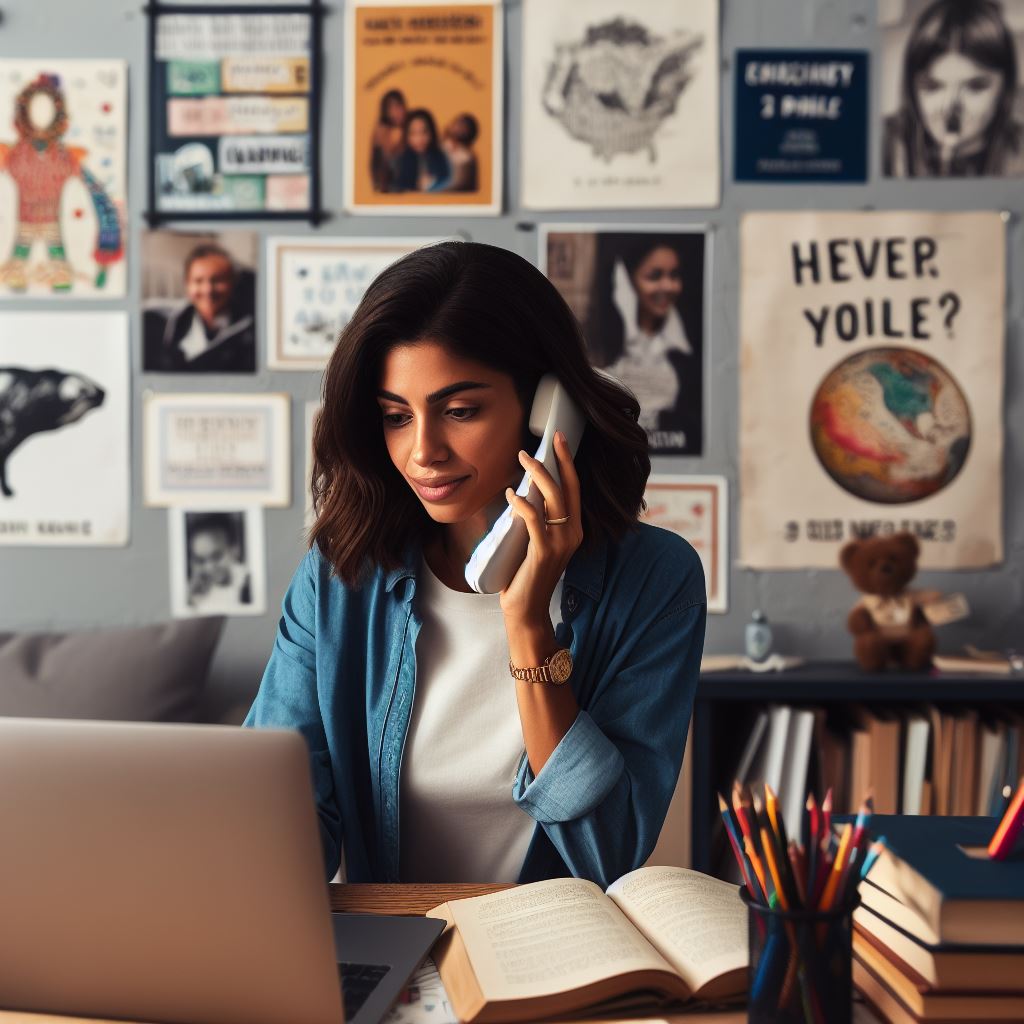Introduction
The US Librarian routine is a fascinating insight into the world of knowledge and information.
Understanding their daily routine is crucial in appreciating their role and importance in society.
Librarians play a crucial role in preserving and disseminating knowledge. Their routine is essential in maintaining the smooth functioning and organization of a library.
An in-depth understanding of a librarian’s routine allows us to grasp the dedication, expertise, and versatility required to serve as a librarian effectively.
In fact, understanding the librarian’s routine is pivotal.
This section has delved into the essence of their tasks, emphasizing the importance of appreciating the intricate dance that sustains the vitality of libraries.
Let us recognize and celebrate the unsung heroes behind the shelves, ensuring the continuity of knowledge for generations to come.
The Morning Routine
Waking up early and starting the day
As a US librarian, my day starts bright and early. The alarm clock goes off at 6 am, and I resist the temptation to hit the snooze button.
Rubbing the sleep from my eyes, I take a moment to gather my thoughts and mentally prepare for the day ahead.
I stretch my limbs, feeling the stiffness of a good night’s sleep, and jump out of bed with renewed energy.
Preparing for work and getting ready
The first task of the morning is to get dressed in my professional attire. Looking presentable is essential as a librarian.
I chose a neat blouse and a pencil skirt, carefully accessorizing with a pair of pearl earrings and a wristwatch.
Running a quick brush through my hair, I ensure that it falls neatly in place, ready to face the day with confidence.
Commuting to the library
- Stepping out of my house, I breathe in the fresh morning air and feel a rush of excitement for the day ahead.
- I hop into my trusty car, start the engine with a purr, and embark on my daily commute to the library.
- The roads are relatively calm at this hour, allowing me to enjoy a peaceful drive while listening to classical music.
- Arriving at the library, I find a parking spot and gather my belongings – my ID, a notepad, and a cup of coffee to go.
- Entering the library’s doors, I am greeted by the familiar scent of books, sending a sense of comfort through my veins.
The morning routine sets the tone for the day as I prepare to serve and assist the library’s visitors.
Each step in the morning routine is vital in ensuring a smooth start to a productive day as a US librarian.
Read: US Public vs. University Libraries: What’s the Difference?
Arriving at the Library
Greeting colleagues and preparing the workspace
When a US librarian arrives at the library, their day kicks off with a series of essential tasks to ensure a productive and efficient workday.
Arriving at the library, the librarian is greeted by their colleagues, exchanging warm hellos and friendly banter, fostering a sense of community within the workspace.
After exchanging pleasantries, the librarian heads straight to their designated workspace, where they prepare their area for the tasks that lie ahead.
They arrange their desk, ensuring everything is clean, tidy, and conducive to their workflow.
Transform Your Career Today
Unlock a personalized career strategy that drives real results. Get tailored advice and a roadmap designed just for you.
Start NowChecking emails and making a to-do list
Once the workspace is ready, the librarian opens their email inbox, ready to tackle any new messages that may have arrived overnight or during their absence.
They promptly respond to urgent inquiries, flagging others that require further attention, and organizing the rest for later action.
With a clear understanding of their email correspondence, the librarian proceeds to create a to-do list for the day.
They carefully prioritize tasks, ensuring that urgent assignments receive immediate attention while designating appropriate time slots for long-term projects.
Setting up for the day’s tasks and organizing materials
- Once the to-do list is finalized, the librarian turns their attention to the day’s tasks and materials.
- They prepare the necessary books, resources, and documents, ensuring everything is within arm’s reach for easy access during their work hours.
- The librarian meticulously organizes these materials, categorizing them based on relevancy, urgency, and the layout of their workspace.
- This organizational approach streamlines the workflow, saving valuable time in the long run and preventing unnecessary rummaging or disruptions during the day.
- In addition to organizing materials, the librarian also takes the time to arrange any necessary equipment or technology needed for the day.
- They ensure that all computers, printers, scanners, and other devices are in proper working order, ready to support their tasks and assist library patrons.
After setting up, the librarian mentally maps their day, reviews priorities, and prepares for tasks.
This mindful approach ensures a confident and focused start for a successful day at the library.
US librarians ensure productivity through efficient email management, organized workflow, and strategic planning, fostering a welcoming environment for patrons.
Serving Patrons
Assisting library users with their inquiries
- Answering questions and addressing concerns from library visitors in a prompt and helpful manner.
- Providing guidance and direction to patrons, ensuring they find the information or materials they need.
- Offering technical support for using library computers, printers, and other equipment.
- Assisting users in accessing online databases, e-books, and digital resources.
- Resolving issues related to library accounts, such as overdue materials or fines.
- Collaborating with other staff members to provide comprehensive assistance to all library users.
Recommending books and providing reading suggestions
- Engaging with patrons to understand their reading preferences, interests, and needs.
- Offering personalized book recommendations based on individual tastes and genres.
- Suggesting popular and new releases, ensuring a diverse selection for different age groups.
- Promoting literature and authors through book displays, book talks, and reading programs.
- Staying updated with literary trends and attending training sessions to enhance book knowledge.
Helping patrons navigate library resources
- Teaching library users how to effectively search the library’s catalog and online databases.
- Assisting in locating specific books, journals, articles, or other materials within the library.
- Demonstrating how to use library research tools to gather information for projects or assignments.
- Providing guidance on citing sources, evaluating information, and conducting thorough research.
- Offering workshops and training sessions on information literacy and research skills.
- Collaborating with teachers and educators to support students’ educational needs.
In short, serving patrons as a librarian is a multifaceted role that requires a range of skills and knowledge.
By assisting with inquiries, recommending books, and helping patrons navigate library resources, I strive to make each person’s experience at the library enjoyable and enriching.
Read: How to Break Into the Librarian Profession in the USA
Conducting Library Activities
Planning and conducting book clubs or storytime sessions
As a librarian, part of my daily routine involves planning and conducting engaging book clubs or storytime sessions for library patrons.
These activities are aimed at promoting literacy and fostering a love for reading among children and adults.
In the planning stage, I choose diverse books for various age groups and interests, including popular titles, classics, and those relevant to current events or themes.
This helps create a dynamic and inclusive reading environment.
Once the book club or storytime session is planned, it’s time to bring it to life.
I start by setting up a cozy and inviting space in the library, and arranging chairs or cushions for listeners to relax.
I also incorporate props, such as puppets or visuals, to enhance the storytelling experience.
When conducting the session, I use an active and engaging tone to capture the audience’s attention.
I encourage participation by asking open-ended questions, allowing listeners to share their thoughts, and creating interactive activities related to the story.
Showcase Your Business Today
Reach thousands of readers actively exploring professional services. Publish your business profile and grow your audience now.
Publish NowThis helps build a sense of community and enthusiasm for reading.
Besides book clubs and storytime sessions, I also prepare and deliver presentations or workshops for library patrons.
These events cover various topics, such as research skills, digital literacy, and using library resources effectively.
Preparing and delivering presentations or workshops
Before presenting, I carefully research and organize the information to ensure it is clear, concise, and relevant.
I create visually appealing slides and handouts to aid comprehension and provide additional resources for further learning.
During the presentation or workshop, I actively engage with the audience by using a combination of verbal and non-verbal communication techniques.
I maintain eye contact, employ gestures, and modulate my voice to emphasize key points and maintain interest.
I also encourage audience participation by asking questions, facilitating discussions, and incorporating hands-on activities or demonstrations.
This interactive approach helps attendees grasp the information better and encourages knowledge retention.
In addition to solo presentations, collaboration with colleagues is an integral part of conducting library activities.
I work closely with other librarians, staff members, and community partners to develop and implement library programming that caters to diverse interests and needs.
Collaborating with colleagues on library programming
- Collaboration begins with brainstorming sessions, where we exchange ideas and identify potential themes or events.
- We discuss community demographics, current trends, and input from library patrons to ensure our programs are inclusive and relevant.
- Once a program idea is finalized, we divide tasks among ourselves, leveraging each person’s strengths and expertise.
- We may work on marketing and promotion, creating program materials, securing guest speakers, or arranging logistics.
- Throughout the planning and implementation process, collaboration continues through regular meetings and communication.
- This ensures everyone is on the same page and any challenges or adjustments are promptly addressed.
By working together, we are able to provide a diverse range of library programs, such as author visits, film screenings, cultural celebrations, and educational workshops.
This collaborative approach enhances the overall library experience and fosters strong community connections.
Conducting various library activities is not just a routine but a rewarding part of being a librarian.
It allows me to inspire a love for reading, empower individuals with knowledge, and create a vibrant and inclusive space for everyone in the community.

Managing Administrative Tasks
As a US librarian, managing administrative tasks is a crucial part of my daily routine.
These tasks ensure the smooth functioning of the library and enhance the overall user experience.
Processing new library materials and keeping the collection organized
One of my primary responsibilities is processing and cataloging new library materials.
I carefully examine each item, input relevant information into the library database, and assign appropriate tags and categories.
This systematic approach ensures easy access and retrieval of materials.
Organizing the library collection is equally important. I regularly assess the arrangement of books and other resources, making sure they are correctly shelved and easily locatable.
This attention to detail allows users to find materials quickly and promotes a sense of order within the library.
Updating library systems and databases
Keeping the library’s systems and databases up to date is crucial for efficient operations.
I regularly perform system updates and ensure that the library management software is functioning smoothly.
This enhances the overall user experience and avoids any technical glitches that might hinder library services.
In addition, I constantly update the library’s online catalog and databases with the latest acquisitions and information.
This includes adding new books, removing outdated materials, and updating any changes in availability.
These regular updates enable users to access the most current information about the library’s collection.
Attending staff meetings and participating in professional development
- To stay updated with the latest practices and changes in the library field, attending staff meetings and engaging in professional development activities is crucial.
- These meetings provide an opportunity to discuss library policies, share insights, and collaborate with colleagues.
- Professional development activities, such as attending workshops, conferences, and training sessions, help me expand my knowledge and improve my skills.
- By staying informed about emerging trends and advancements in librarianship, I can offer enhanced services and resources to library users.
Overall, managing administrative tasks ensures the efficient functioning of the library and enhances the user experience.
During the planning stage, I select a variety of books for different age groups and interests, including popular, classic, and relevant titles.
Read: The Role of Librarians in US Public Education Systems
Lunch Break and Personal Time
Taking a break and having lunch
- Stepping away from the librarian duties to recharge and refuel.
- Enjoying a wholesome meal to maintain energy levels throughout the day.
- Using this time to replenish and nourish both the body and mind.
- Taking advantage of the lunch break as a chance to relax and rejuvenate.
- Indulging in a nutritious lunch to enhance productivity and focus.
Engaging in personal activities during free time
- Utilizing the break for personal hobbies or interests to unwind.
- Reading a book, catching up on favorite blogs, or exploring the latest news.
- Engaging in physical activities like going for a brisk walk or quick workout.
- Listening to podcasts, music, or audiobooks to stimulate the mind.
- Take a few moments to express creativity through drawing, painting, or writing.
Relaxing or socializing with colleagues
- Taking time to foster relationships with fellow librarians.
- Engaging in conversations to share knowledge, experiences, and ideas.
- Building a sense of camaraderie and teamwork within the library community.
- Participating in group activities or games for relaxation and fun.
- Creating a supportive and inclusive environment through socializing during breaks.
In essence, the lunch break and personal time in a librarian’s routine are invaluable for recharging, personal growth, and fostering a positive work atmosphere.
It provides an opportunity to step away from the responsibilities and engage in activities that promote well-being, creativity, and social connection.
By taking this time to relax, pursue personal interests, and socialize with colleagues, librarians can maintain a healthy work-life balance and enhance their overall job satisfaction.
Afternoon Tasks
Resuming serving library users and assisting with queries
After a fulfilling lunch break, the afternoon brings a fresh wave of tasks for the dedicated US librarian.
With renewed energy, they resume serving the library users, ready to assist with any inquiries they may have.
Each interaction is an opportunity to engage, guide, and empower individuals in their quest for knowledge.
Continuing administrative tasks and managing projects
The librarian’s role goes beyond assisting library patrons. They also have administrative tasks that need attention.
This entails managing projects, developing strategies, and monitoring the progress of ongoing initiatives.
Organization and multitasking skills are key as they keep track of deadlines, budgets, and stakeholder expectations.
Showcase Your Business Today
Reach thousands of readers actively exploring professional services. Publish your business profile and grow your audience now.
Publish NowEngaging in ongoing professional development
Engaging in ongoing professional development is essential for librarians to stay ahead in a rapidly evolving field.
- The afternoon presents the perfect opportunity to invest time in acquiring new skills, expanding knowledge, and keeping up with the latest trends.
- This can involve attending workshops, webinars, or conferences, as well as dedicating time to reading professional literature and networking with colleagues.
- The librarian is often found juggling multiple responsibilities simultaneously during the afternoon.
- They may be conducting a research session with a user while simultaneously answering phone calls and responding to emails.
- This level of multitasking requires focus, effective communication, and a deep understanding of library resources and services.
- Furthermore, the librarian’s dedication to providing excellent customer service is unwavering.
- They strive to create a welcoming and inclusive environment for all library users, ensuring equitable access to resources and promoting a sense of belonging.
- This includes collaborating with diverse communities, implementing outreach programs, and adapting services to cater to unique demographic needs.
Beyond their core duties, librarians consistently pursue chances to enhance efficiency and effectiveness.
They actively solicit feedback from users and stakeholders, utilizing data and technology to streamline processes and improve the library experience.
During collaborative afternoon sessions, librarians exchange best practices and innovative ideas, fostering growth and contributing to the advancement of the library field.
Basically, the afternoon tasks of a US librarian are varied and demanding.
Librarians play a crucial role in facilitating knowledge access and promoting lifelong learning through serving users, managing tasks, and engaging in professional development.
Their dedication and passion for their profession make libraries vibrant and invaluable spaces within the community.
Read: Future of Libraries: Technology and Trends in the USA
Wrapping up the Day
Finishing pending tasks and closing up the library
- Complete any unfinished tasks, such as cataloging books or organizing shelves.
- Ensure all computers and equipment are turned off and securely locked up.
- Double-check that all doors and windows are closed and locked properly.
- Put away any remaining materials, such as pens, paper, or reference materials.
- Clean up any messes or spills, ensuring the library is tidy and organized for the next day.
Reviewing the day’s accomplishments and reflecting on challenges
- Take a few moments to review the tasks completed throughout the day.
- Reflect on any challenges or obstacles faced and consider possible solutions for the future.
- Recognize and celebrate any major accomplishments or milestones achieved.
- Take note of any areas where improvement or additional training may be beneficial.
Preparing for the next day’s tasks and scheduling
- Create a to-do list for the next day, prioritizing tasks based on importance and urgency.
- Review the calendar for any upcoming meetings, events, or deadlines that need to be prepared for.
- Set reminders or alarms for important tasks or reminders that need to be attended to.
- Organize any materials or resources that will be needed for the following day.
- Ensure all necessary resources, such as books or databases, are accessible and ready to be used.
Wrapping up the day as a librarian involves completing pending tasks, closing up the library, and reflecting on the day’s accomplishments and challenges.
It also requires preparing for the next day’s tasks and scheduling to ensure a smooth and productive workflow.
By following these steps, librarians can efficiently end their day and set themselves up for success in the future.
Conclusion
A US librarian’s routine is a complex balance of various tasks and responsibilities.
They handle everything from cataloging books to assisting patrons with research, all while fostering a sense of community within the library.
Librarians play a vital role in fostering community and knowledge. They provide a safe space for people to learn and connect, promoting literacy and intellectual growth.
Their expertise and resources are essential in guiding individuals toward reliable information.
In closing, librarians have a profound impact on society by nurturing curiosity, promoting lifelong learning, and bridging the gap between individuals and information.
Their dedication to fostering knowledge makes libraries valuable assets within our communities.
[E-Books for Sale]
The Big Book of 500 High-Paying Jobs in America: Unlock Your Earning Potential
$19.99 • 500 High-Paying Jobs • 330 pages
Explore 500 high-paying jobs in America and learn how to boost your career, earn more, and achieve success!
See All 500 High-Paying Jobs of this E-Book
1001 Professions Without a Degree: High-Paying American Jobs You Can Start Now
$19.99 • 1001 Professions Without a Degree • 174 pages
Discover 1001 high-paying jobs without a degree! Unlock career tips, skills, and success strategies for just $19.99!




